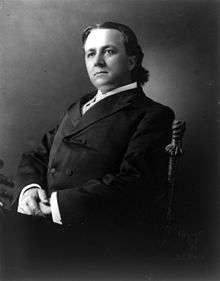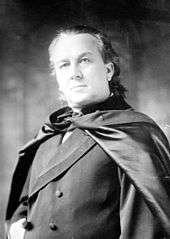James K. Vardaman
James Kimble Vardaman (July 26, 1861 – June 25, 1930) was an American politician from the U.S. state of Mississippi and was the Governor of Mississippi from 1904 to 1908. A Democrat, Vardaman was elected in 1912 to the United States Senate in the first popular vote for the office, following adoption of the 17th Amendment. He defeated incumbent LeRoy Percy, a member of the planter elite. Vardaman served from 1913 to 1919.
James K. Vardaman | |
|---|---|
 | |
| United States senator from Mississippi | |
| In office March 4, 1913 – March 3, 1919 | |
| Preceded by | LeRoy Percy |
| Succeeded by | Byron P. Harrison |
| 36th Governor of Mississippi | |
| In office January 19, 1904 – January 21, 1908 | |
| Lieutenant | John Prentiss Carter |
| Preceded by | Andrew H. Longino |
| Succeeded by | Edmond Favor Noel |
| Member of the Mississippi House of Representatives | |
| In office 1890–1896 | |
| Personal details | |
| Born | James Kimble Vardaman July 26, 1861 Jackson County, Texas |
| Died | June 25, 1930 (aged 68) Birmingham, Alabama |
| Resting place | Lakewood Memorial Park, Jackson, Mississippi, U.S. |
| Political party | Democratic |
| Spouse(s) | Anna Burleson Robinson |
| Military service | |
| Nickname(s) | "The Great White Chief" |
| Allegiance | |
| Branch/service | |
| Rank | |
| Battles/wars | Spanish–American War |
Known as "The Great White Chief", Vardaman had gained electoral support for his advocacy of populism and white supremacy, saying: "If it is necessary every Negro in the state will be lynched; it will be done to maintain white supremacy."[1] He appealed to the poorer whites, yeomen farmers, and factory workers.
Early life and education
Vardaman was born in the Confederacy, a fact he often remembered. He was born in Jackson County, Texas, in July 1861.[2] He moved to Mississippi, where he studied law and passed the bar. He settled in Greenwood, Mississippi, becoming editor of The Greenwood Commonwealth.
Career


After the Reconstruction era, Mississippi election campaigns were frequently marked by violence and fraud. A biracial coalition of Republicans and Populists briefly controlled the governorship and Mississippi House in the late 1880s.
As a Democrat, Vardaman served in the Mississippi House of Representatives from 1890 to 1896 and was elected as its speaker in 1894. He was known for his populist appeal to the common man. State Democrats took action to ensure that they did not lose power again. After having gained control of the legislature by suppressing the black vote, they passed a new constitution in 1890 with provisions, such as a poll tax and literacy test, that raised barriers to voter registration and disenfranchised most blacks.
Referring to the 1890 Mississippi state constitution, Vardaman said:
There is no use to equivocate or lie about the matter.... Mississippi's constitutional convention of 1890 was held for no other purpose than to eliminate the nigger from politics. Not the 'ignorant and vicious', as some of the apologists would have you believe, but the nigger.... Let the world know it just as it is.... In Mississippi we have in our constitution legislated against the racial peculiarities of the Negro.... When that device fails, we will resort to something else.[3]
Vardaman was commissioned as a major in the US Army during the Spanish–American War and served in Puerto Rico.
Vardaman ran twice in Democratic primaries for governor, in 1895 and 1899, but was not successful. The state was virtually one-party, and winning the Democratic primary was tantamount to victory in the general election for any office. In 1903 Vardaman won the primary and the general elections for governor, serving one four-year term (1904–1908). In the election, he said that "a vote for Vardaman is a vote for white supremacy, a vote for the quelling of the arrogant spirit that has been aroused in the blacks by Roosevelt and his henchmen, ...a vote for the safety of the home and the protection of our women and children."[4]
In late December 1906, he went to Scooba, in rural Kemper County, with the Mississippi National Guard, to ensure that control was established. Whites had rioted against blacks there and in Wahalak and feared retaliation; in total, two white men were killed and 13 blacks. The events were covered by the Associated Press and the New York Times, among other newspapers.[5][6]
By 1910, his political coalition of chiefly poor white farmers and industrial workers began to identify proudly as "rednecks." They began to wear red neckerchiefs to political rallies and picnics.[7]
Vardaman advocated a policy of state-sponsored racism against blacks and said that he supported lynching to maintain white supremacy.[1] From 1877 to 1950, Mississippi had the highest number of lynchings in the nation.[8] He was known as the "Great White Chief."[9]
Vardaman was elected to the US Senate in 1912 in the first popular election of the state's senators by defeating the incumbent LeRoy Percy, a member of the planter elite. He ran on a platform of repealing the Fourteenth and Fifteenth Amendment, which gave blacks the vote and other rights. Vardaman served one term, from 1913 until 1919. He was defeated in his primary re-election bid in 1918. The main factor in his defeat was his vote against the US declaration of war on Germany and the entry into World War I. Only five other senators voted with him.
Vardaman ran in the Democratic primary for the US Senate in 1922 but was defeated in the primary runoff by US Representative Hubert Stephens by 9,000 votes.[10]
Rhetoric
Vardaman was known for his provocative speeches and quotes and once called Theodore Roosevelt a "little, mean, coon-flavored miscegenationist."[11] In reference to the education of black children, he remarked, "The only effect of Negro education is to spoil a good field hand and make an insolent cook."[12] "The knowledge of books does not seem to produce any good substantial result with the Negro, but serves to sharpen his cunning, breeds hopes that cannot be fulfilled, creates an inclination to avoid labor, promotes indolence, and in turn leads to crime."[13]:105
After the president of Tuskegee University, Booker T. Washington, had dined with Roosevelt, Vardaman said that the White House was "so saturated with the odor of the nigger that the rats have taken refuge in the stable."[14]
Referring to Washington's role in politics, Vardaman said: "I am opposed to the nigger’s voting, it matters not what his advertised moral and mental qualifications may be. I am just as much opposed to Booker Washington, with all his Anglo-Saxon reenforcement, voting, as I am to voting by the cocoanut-headed, chocolate-colored typical little coon, Andy Dotson, who blacks my shoes every morning. Neither one is fit to perform the supreme functions of citizenship."[15][16]
Personal life, death and legacy
Vardaman married Anna Burleson Robinson. Their son, James K. Vardaman, Jr., later was appointed as Governor of the Federal Reserve System, serving from 1946 to 1958.[17]

Vardaman died on June 25, 1930, at the age of 68, at Birmingham Hospital in Birmingham, Alabama.[18]
In July 2017, the University of Mississippi announced that Vardaman's name would be removed from a building that has borne his name since it was built in 1929, but it still has not been removed as of June 2020.[19][20][21]
In William Faulkner's novel As I Lay Dying, a character in the Bundren family is named after the Governor, presumably because the Bundrens are a family of poor, rural whites, one of Governor Vardaman's key constituencies.
References
- Public Broadcasting Service (September 2008). "People & Events: James K. Vardaman". American Experience. Corporation for Public Broadcasting. Archived from the original on March 20, 2012. Retrieved September 21, 2008.
If it is necessary every Negro in the state will be lynched; it will be done to maintain white supremacy.
- Biographical Directory of the United States Congress.
- McMillen, Neil R. "The Politics of the Disfranchised". Dark Journey: Black Mississippians in the Age of Jim Crow. pp. 41–44. Retrieved August 1, 2015.
- Blow, Charles M. (May 27, 2020). "How White Women Use Themselves as Instruments of Terror". New York Times.
- "Whites in Race War Kill Blacks Blindly/ Innocent Negroes Shot in the Mississippi Trouble", New York Times, 26 December 1906; accessed 20 March 2017
- Associated Press, "Situation in Scooba Is Now Under Full Control", Pensacola Journal (front page), 28 December 1906; accessed 20 March 2017
- Kirwan, Albert D. (1951). Revolt of the Rednecks: Mississippi Politics 1876–1925. University of Kentucky Press. p. 212. OCLC 3371463.
- Lynching in America: Confronting the Legacy of Racial Terror, 2nd edition Archived June 27, 2018, at the Wayback Machine, Equal Justice Initiative, 2015
- Mullins, Philip. "The Revolt of the Rednecks". The Ancestors Of George & Hazel Mullins. University of Texas at Austin.
- Street, William B. (March 21, 1965). "The Man Who Invented The Redneck". The Commercial Appeal.
- "Theodore Roosevelt and Civil Rights". Theodore Roosevelt Association. Retrieved September 21, 2008.
- Wilkerson, Isabel. The Warmth of Other Suns (2010), p. 40
- "The Earliest Black Graduates of the Nation's Highest-Ranked Liberal Arts Colleges". Journal of Blacks in Higher Education (38). 2002. pp. 104–109. JSTOR 3134222.
- Wickham, DeWayne (February 14, 2002). "Book fails to strip meaning of 'N' word". USA Today.
It is as noxious today as in 1901 when Mississippi Sen. James Vardaman said after Booker T. Washington had dined with President Theodore Roosevelt that the White House was "so saturated with the odor of the nigger that the rats have taken refuge in the stable."
- "The Authentic Voice". Time. March 26, 1956.
- https://cdn.loc.gov/service/rbc/lcrbmrp/t2609/t2609.pdf
- James K. Vardaman, Jr.: Governor (Board of Governors): 1946 - 1958
- "J. K. Vardaman, Ex-senator, Dies. Mississippian Succumbs to Long Illness in a Birmingham Hospital. Was a governor. One of Six Senators Who Voted Against War With Germany. Lawyer and Editor". New York Times. June 26, 1930. Retrieved March 23, 2010.
James Kimball Vardaman, former Governor of Mississippi and a United States Senator from that State, familiarly known to thousands as 'the White Chief,' died at a hospital here today after a lengthy illness. His age was 68.
- "University of Mississippi to post sign recognizing slave labor on campus". CBS News. July 6, 2017. Retrieved December 10, 2018.
- Vardaman Hall Name Change Recommended By Committee For Contextualization hottytoddy.com March 7, 2017 Retrieved July 9, 2017
- https://hottytoddy.com/2019/10/24/sasi-calls-to-remove-names-ingrained-in-white-supremacy-from-campus-buildings/
Further reading
- Holmes, William F. (1970). The White Chief: James Kimble Vardaman. Baton Rouge: Louisiana State University Press. ISBN 0-8071-0931-2.
External links
| Wikimedia Commons has media related to James K. Vardaman. |
- "Vardaman's Weekly Online". Retrieved April 21, 2010.
- James Kimble Vardaman at Find a Grave
| Party political offices | ||
|---|---|---|
| Preceded by Andrew H. Longino |
Democratic nominee for Governor of Mississippi 1903 |
Succeeded by Edmond Noel |
| Political offices | ||
| Preceded by Andrew H. Longino |
Governor of Mississippi 1904–1908 |
Succeeded by Edmond Noel |
| U.S. Senate | ||
| Preceded by Le Roy Percy |
U.S. senator (Class 2) from Mississippi 1913–1919 Served alongside: John Sharp Williams |
Succeeded by Pat Harrison |
.svg.png)
